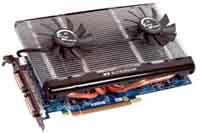I can pass on a few things
1. You will have to raise Vcore. There is no getting around that if you want to push the memory controller. The traditional northbridge memory controller is part of the A64 CPU, not the motherboard IC and therefore it requires higher Vcore to keep the CPU stable well past the designed q of the processor.
2. When you raised Vcore the temp was excessive as compared to what I have seen in the past for similar processor. Typically you should be able to run a 1.65-1.70 Vcore with the right heatsink system and mainatin about 55c. It may creep up a tad higher however its not so much the temp itself when it gets to 53-56c, but the speed of heat conductivity and transfer taking place. You can have 55c crash on a cheap HSF and work fine on a good one
3. The voltage drops as you increased Vcore indicate the 3.3-5v rail may have met their match. When you see a 12v drop from a Vcore increase its an indication the PSU 3.3+5v cross regulation to the 12v has peaked and drawing the 12v rail down in order to maintain. That drop also indicates the memory is loosing current as well.
4. I am not sure about Everest when it comes to monitoring however it may be reading the AMD K8 internal temp monitor just fine. I do know the program SPEEDFAN comes with support to read the true AMD K8 internal sensor. Some programs read 5-8c cooler than the AMD K8 internal. It is possible your current CPU cooler is simply not up to the task because if the readings you are getting are not from the true core of the processor it may be hotter than you think. You must properly enable the K8 function in SPEEDFAN to see the true core temp as the processor sees it.
When I started running the Sandy well over a year or so ago I was on a Thermaltake Vocano
http://www.newegg.com/Product/Product.a ... 6835106035 which did the job very well. I moved to a Zalman
http://www.newegg.com/Product/Product.a ... 6835118004 later as I was playing with other processors that required a bit more in that area.
There is a chip on the motherboard for the clock generator. This IC is rarely cooled with a heatsink of any type. One thing I always do is find all the cookers on the motherboard using a thermal probe and glue a heatsink on them. The clockgen IC will usually get hot enough to blister a finger without such cooling. I do not know where it is located on your board. With a good picture I could probably locate it, most likely somewhere around the memory banks. Its a rectangular shaped IC about 1/4" x 3/4" and during high clock you should have no problem finding it by careful touch. Typical PLL clock gen chips have a number that starts with: ICSxxxxx
EDIT: I found a picture of the board
http://www.pcper.com/image.php?aid=98&img=board_big.jpg I see 3 possibilities for the PLL.
At the top/center where the hole is showing just above the CPU socket, look to the left of that hole about 1/2 inch higher than the hole and you will see a rectagular IC. Check that one for heat.
And other possibility is just above/center/right of the blue PCIE slot.
And another would be the IC located next to the top edge of the floppy controller plug
EDIT: I see one other possibility but I have never seen a PLL located at the bottom of a board. Bottom left just under the black SATA plugs next to the BIOS chip
Run a high stable clock for a few minutes and check those IC's carefully for heat. If they are simply warm, its not a problem but if one of them is cooking, carefully epoxy of a heatsink on it may net a more stable clock.
typical Asus El-cheapo fan on the chipset
If my memory serves me right, the rated speed of the A8N PLL is 300Mhz. Anything higher by 10Mhz+ and I think you are loosing more than gaining even if you can run stable. I am curious about running a 9x300 @ DDR333, Vcore @ 1.5-1.55. If the math is correct the memory will run @ 270Mhz @ 2.8v and the CPU at 2700.
I do think from the tests you have run, 1T may not be possible, stable, on those sticks above 240Mhz. We need to find out if the math on the 1/2 multipliers is accurate at higher bus speeds. Running 3-4-4-11 1T @ 9.5 x 285 1.55 Vcore your CPU should be at 2707.5 and the memory around 225-226. If it isn't and running lower, then there could be a break for you in that. If it wont run 1T at 225-226 with a decent Vcore then there is a limit in the memory sticks and the wall for it is most likely around 220 @ 1T. If it does run 1T @ 225, I would increase the FSB to 290 and test again which should bring the memory up to 229-230Mhz
If that 9.5x 285 test shows a memory speed significanlty lower than 225-226, then Asus has messed with the table on the 1/2 multiplier. That could be a benefit if the 3-4-4-11 1T wall is @ 220.
If the 1T wall is 220 then most likely the chips on the modules are mixed and that may be why they got the DDR400 rating. That would be in line with the max q on the module being 270-280 because 50MHz under places in in that range and with the voltage drop I am seeing and running a lower Vcore, it would be logical to assume 220-230 would be the wall @ 1T with high FSB.
As for the method you are using, not crtique from me.... getting to know a system and its electronic personality requires using methods that you feel comfortable in.
I would typically run the loose timing @ 1T and work the numbers, verifying the CPU/DRAM ratio and using the math I posted to confirm the numbers are in line.


 Mainboard: Asus P5K-Premium, CPU=Intel E6850 @ x8x450fsb 3.6ghz, RAM: 4gb PC8500 Team Dark, Video: NV8800GT, HDD: 2x1Tb Samsung F3 RAID-0 + 1Tb F3, PSU: Antec 550 Basiq, OS: Win7x64, Display: 24&
Mainboard: Asus P5K-Premium, CPU=Intel E6850 @ x8x450fsb 3.6ghz, RAM: 4gb PC8500 Team Dark, Video: NV8800GT, HDD: 2x1Tb Samsung F3 RAID-0 + 1Tb F3, PSU: Antec 550 Basiq, OS: Win7x64, Display: 24&
